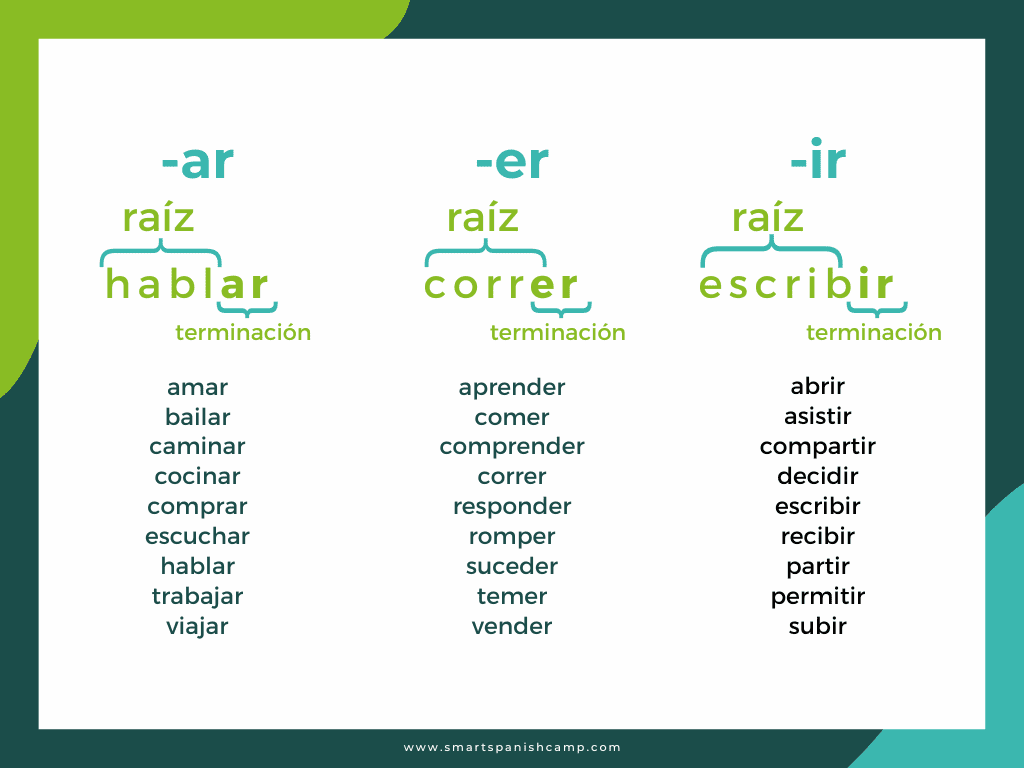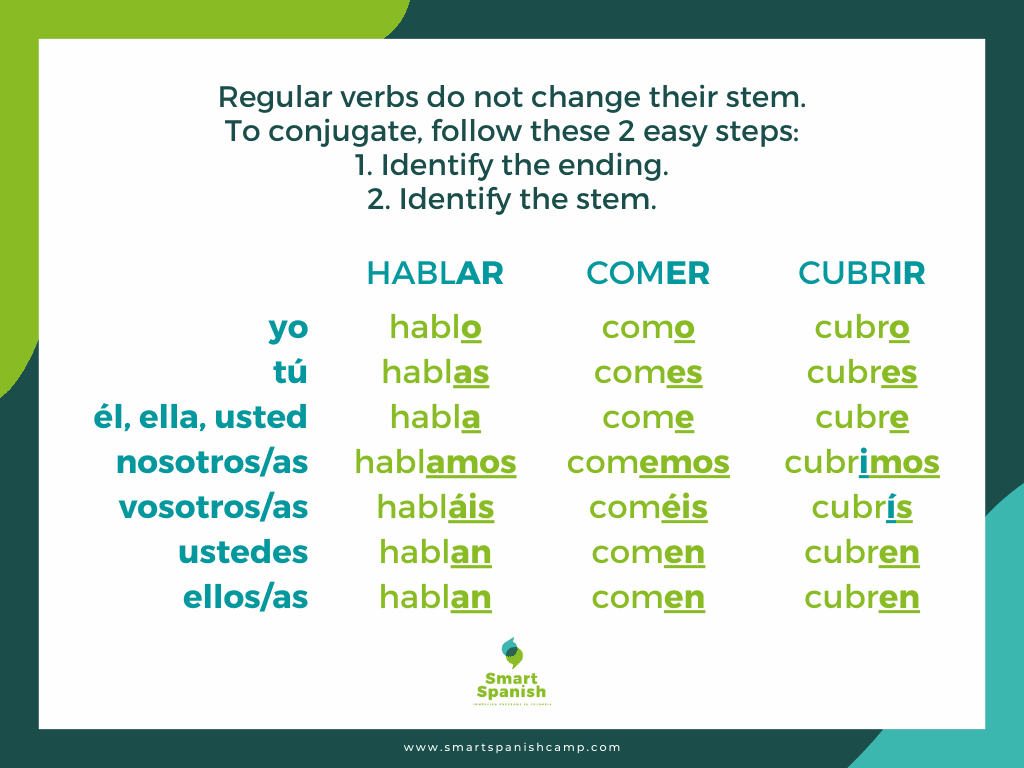When it comes to learning Spanish, mastering verb conjugation is like unlocking a whole new world of communication. It’s the key to expressing actions in the present, and it’s a fundamental skill for anyone on their journey to becoming fluent in Spanish. In this blog post, we’ll explore the importance of identifying the subject for conjugation and delve into the world of conjugating both regular and irregular verbs in the present tense.
The Importance of Identifying the Subject
One of the first steps in conjugating verbs in Spanish is identifying the subject of the sentence. Unlike English, where the verb form often remains the same regardless of the subject (e.g., “I speak,” “You speak”), Spanish verbs change depending on the subject. This means that understanding who or what is performing the action is crucial.
Let’s take a look at a simple example using the verb “hablar” (to speak):
- Yo hablo – I speak
- Tú hablas – You speak
- Él/Ella habla – He/She speaks
- Nosotros/Nosotras hablamos – We speak
- Vosotros/Vosotras habláis – You all speak
- Ellos/Ellas hablan – They speak
Notice how the verb “hablar” changes based on the subject of the sentence. To conjugate verbs correctly, you need to know who’s doing the action. This helps you communicate clearly and accurately.
Conjugating Regular Verbs
In Spanish, regular verbs follow predictable patterns when conjugated. They are categorized into three groups based on their endings: -ar, -er, and -ir. Let’s take a look at how each group is conjugated in the present tense:

-ar Verbs (e.g., hablar – to speak):
- Drop the -ar ending.
- Add the appropriate present tense endings for each subject.
-er Verbs (e.g., comer – to eat):
- Drop the -er ending.
- Add the appropriate present tense endings for each subject.
-ir Verbs (e.g., vivir – to live):
- Drop the -ir ending.
- Add the appropriate present tense endings for each subject.

Conquering Irregular Verbs
While regular verbs follow clear patterns, irregular verbs in Spanish don’t conform to these patterns, making them a bit trickier to conjugate. However, many common verbs are irregular, so it’s essential to learn them.
Irregular verbs don’t follow the typical -ar, -er, or -ir conjugation patterns, making them a unique challenge for Spanish learners. We’ll explore some of the most common irregular verbs, including complete irregulars, boot verbs, and verbs that change in the “yo” form.
1. Complete Irregular Verbs: “Ser” and “Ir”
Ser (to be):
- Yo soy – I am
- Tú eres – You are
- Él/Ella es – He/She is
- Nosotros/Nosotras somos – We are
- Vosotros/Vosotras sois – You all are
- Ellos/Ellas son – They are
Ir (to go):
- Yo voy – I go
- Tú vas – You go
- Él/Ella va – He/She goes
- Nosotros/Nosotras vamos – We go
- Vosotros/Vosotras vais – You all go
- Ellos/Ellas van – They go
These verbs are entirely irregular in the present tense, and their forms must be memorized. However, they are incredibly common and foundational in everyday conversation.
2. Boot Verbs:
Boot verbs are a type of irregular verb where the stem vowel changes in some conjugations but follows a pattern. Here’s an example using “comenzar” (to begin):
2.1 Comenzar (to begin):
- Yo comienzo – I begin
- Tú comienzas – You begin
- Él/Ella comienza – He/She begins
- Nosotros/Nosotras comenzamos – We begin
- Vosotros/Vosotras comenzáis – You all begin
- Ellos/Ellas comienzan – They begin
Notice how the stem vowel “e” changes to “ie” in some forms. Many verbs in Spanish, especially those ending in -ar and -er, follow this pattern. In the category where the stem vowel transforms from “e” to “ie,” we find verbs like pensar (to think), cerrar (to close), empezar (to start), sentir (to feel), and perder (to lose).
2.2 Pedir (to ask for/request):
“Pedir” is another boot verb that experiences stem vowel changes. Here’s its present tense conjugation:
- Yo pido – I ask for/request
- Tú pides – You ask for/request
- Él/Ella pide – He/She asks for/requests
- Nosotros/Nosotras pedimos – We ask for/request
- Vosotros/Vosotras pedís – You all ask for/request
- Ellos/Ellas piden – They ask for/request
In this case, the stem vowel “e” changes to “i” in some forms. In the group where the stem “e” morphs into “i,” we meet decir (to say/tell), pedir (to ask for/request), repetir (to repeat), medir (to measure), and vestir (to dress).
2.3 Dormir (to sleep):
“Dormir” is a boot verb where the stem vowel changes to “ue.” Here’s its present tense conjugation:
- Yo duermo – I sleep
- Tú duermes – You sleep
- Él/Ella duerme – He/She sleeps
- Nosotros/Nosotras dormimos – We sleep
- Vosotros/Vosotras dormís – You all sleep
- Ellos/Ellas duermen – They sleep
If the stem “o” changes to “ue,” we encounter verbs such as volver (to return), poder (to be able to/can), doler (to hurt), recordar (to remember), and encontrar (to find).
2.4 Jugar (to play):
“Jugar” is a boot verb with a stem vowel change as well. Here’s its present tense conjugation:
- Yo juego – I play
- Tú juegas – You play
- Él/Ella juega – He/She plays
- Nosotros/Nosotras jugamos – We play
- Vosotros/Vosotras jugáis – You all play
- Ellos/Ellas juegan – They play
In this case, the stem vowel “u” changes to “ue” in some forms. Jugar is the only verb in this group!
Boot verbs add a layer of complexity to Spanish verb conjugation, but once you understand the patterns, they become more manageable. Practicing these verbs will enhance your conversational skills and help you express a wide range of actions and requests in Spanish. So, keep practicing, and soon, these boot verbs will feel like second nature!
3. Verbs Irregular with “Yo”:
Some verbs are irregular only in the “yo” form (first person singular). Here are a few examples:
Hacer (to do/make):
- Yo hago – I do/make
- Tú haces – You do/make
- Él/Ella hace – He/She does/makes
- Nosotros/Nosotras hacemos – We do/make
- Vosotros/Vosotras hacéis – You all do/make
- Ellos/Ellas hacen – They do/make
Tener (to have):
- Yo tengo – I have
- Tú tienes – You have
- Él/Ella tiene – He/She has
- Nosotros/Nosotras tenemos – We have
- Vosotros/Vosotras tenéis – You all have
- Ellos/Ellas tienen – They have
Salir (to go out/leave):
- Yo salgo – I go out/leave
- Tú sales – You go out/leave
- Él/Ella sale – He/She goes out/leaves
- Nosotros/Nosotras salimos – We go out/leave
- Vosotros/Vosotras salís – You all go out/leave
- Ellos/Ellas salen – They go out/leave
Decir (to say/tell):
- Yo digo – I say/tell
- Tú dices – You say/tell
- Él/Ella dice – He/She says/tells
- Nosotros/Nosotras decimos – We say/tell
- Vosotros/Vosotras decís – You all say/tell
- Ellos/Ellas dicen – They say/tell
These verbs exhibit changes unique to the “yo” form, often involving vowel changes or irregular consonant shifts.
Conquering irregular verbs is essential for achieving fluency in Spanish. By understanding and practicing these irregularities, you’ll enhance your ability to communicate effectively in various situations. Whether it’s the uniqueness of “ser” and “ir,” the stem changes in boot verbs, or the quirks of “yo”-irregular verbs, mastering these irregularities will open up new possibilities in your Spanish language journey. So, embrace the challenge and keep practicing!
Conclusion
Conjugating verbs in the present tense is a fundamental aspect of Spanish grammar. It allows you to express actions happening right now and is crucial for effective communication. Start by identifying the subject of the sentence, and then apply the appropriate conjugation rules for regular and irregular verbs.
Whether you’re ordering food in a Spanish-speaking restaurant, chatting with native speakers, or simply enhancing your language skills, mastering the present tense will open doors to a more immersive and enjoyable Spanish experience. So, ¡vamos! Let’s dive into the world of Spanish verb conjugation and take your language skills to the next level.

